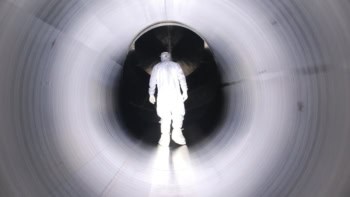A group of physicists in Germany claims to have discovered a way of speeding up radioactive decay that could render nuclear waste harmless on timescales of just a few tens of years. Their proposed technique – which involves slashing the half-life of an alpha emitter by embedding it in a metal and cooling the metal to a few degrees kelvin – could therefore avoid the need to bury nuclear waste in deep repositories, a hugely expensive and politically difficult process. But other researchers are sceptical and believe that the technique contradicts well-established theory as well as experiment.

The leader of the German-based group, Claus Rolfs of Ruhr University in Bochum, is an astrophysicist and made the discovery about alpha decay after replicating the fusion reactions that take place in the centre of stars. Using the university’s particle accelerator he fired protons and deuterons (nuclei containing a proton and a neutron) at various light nuclei. He noticed that the rate of fusion reactions was significantly greater when the nuclei were encased in metals than when they were inserted into insulators. He also observed that the effect is enhanced at lower temperatures (J. Phys. G: Nucl. Part. Phys. 32 489).
Rolfs believed this effect could be explained in simple terms by assuming that the free electrons in a metal act like the electrons in a plasma, as described in a model by Dutch physicist Peter Debye. The lower the temperature of the metal, the closer the free electrons get to the radioactive nuclei. These electrons accelerate positively charged particles towards the nuclei, thereby increasing the probability of fusion reactions.
But Rolfs realized that the reverse reaction might also occur and that free electrons could enhance the ejection of positively charged particles from a nucleus. This would reduce the half-lives of α-decay or β+-decay, and increase half-lives for processes involving electrons (which are repelled by the free electrons within the metal), i.e. β–-decay and electron capture.
The group has investigated this hypothesis by embedding a number of radioactive nuclei inside metals and then cooling the metal to a few degrees kelvin. As expected, they observed a longer half-life for the electron capture of beryllium-7 and shorter half-lives for β+-decay in sodium-22 (Eur. Phys. J. A 28 251) and α-decay in polonium-210. They are now investigating the α-decay of radium-226, a hazardous component of spent nuclear fuel with a half-life of 1600 years. Rolfs calculates that this half-life could be reduced to as little as a year and at the very least to 100 years, and believes that the half-lives of all other hazardous alpha emitters within nuclear waste could be shortened by similar amounts.
“This means that nuclear waste could probably be dealt with entirely within the lifetimes of the people that produce it,” he says. “We would not have to put it underground and let our great-great-grandchildren pay the price for our high standard of living.”
Rolfs admits that much engineering research needs to be done to convert his idea into practice, but he believes there are probably no insurmountable technical barriers. Other physicists, however, think that the basic idea may be flawed. According to Nick Stone, a nuclear physicist recently retired from Oxford University, physicists have already carried out experiments in which they cooled alpha emitters to 4 K and below, but found no significant changes in their half-lives.
Meanwhile, Hubert Flocard, director of the CSNSM nuclear-physics lab near Paris, believes that Rolfs’ model contradicts standard solid-state physics, although he admits that he cannot explain the group’s data himself. Rolfs concedes that he needs a more sophisticated theory, but stands by his results. “Nature decides what is right,” he says.



